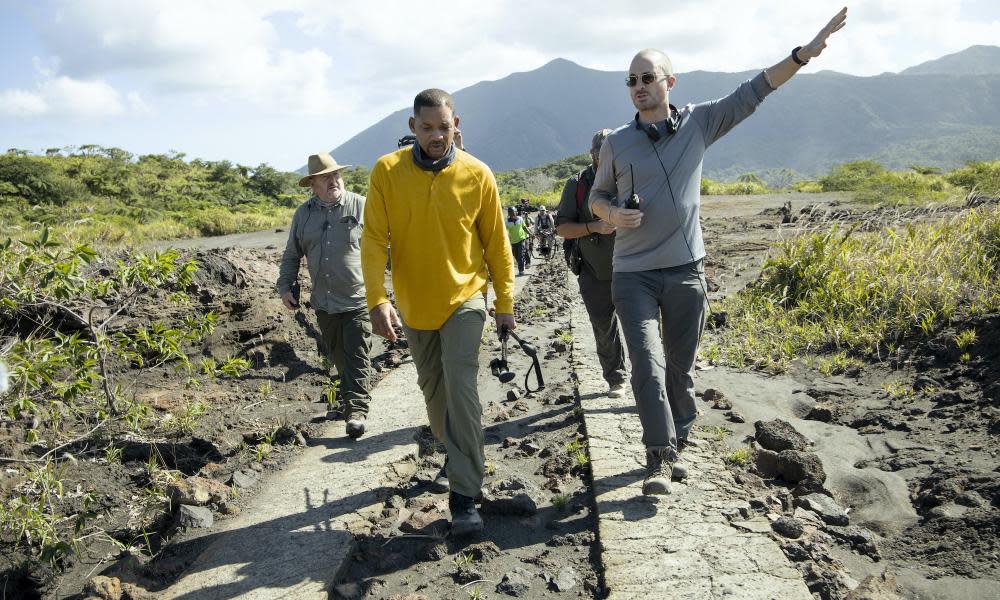Welcome to Earth review – Will Smith has Important Things to say, but he’s no Attenborough

Will Smith is looking worried. He’s about to traverse a mighty gorge by rope – and if a fall doesn’t kill him, the crocodiles in the river below will. Safely on the other side, having been hauled across by Albert Lin, an explorer, he laughs deliriously. In a movie, he says, a stuntman would have done that for him. Smith gets to have lots of new and scary experiences in Welcome to Earth, a six-part National Geographic series (Disney+). Here he is abseiling down a cavernous ice hole, there he is going to the bottom of the ocean in a submersible – all with a look of terror settling across his face.
This is nature documentary, Hollywood-style, produced by the film-maker Darren Aronofsky. It’s the second time he and Smith have taken Earth as their set (they also made the 2018 series One Strange Rock). You can take the men out of Hollywood, etc. The soundtrack is relentless, there are banal messages – delivered in artfully lit black-and-white cutaways – about Important Things such as conquering fear, or the beauty of the world; and a cast of photogenic adventurers who accompany Smith “to the ends of the Earth – and beyond”. There is a lot of ramped-up drama – at one point, a diver goes swimming with manta rays, languid as a soft-close toilet seat, and we’re supposed to believe it’s incredibly dangerous, like a scene from Jaws.
The idea of the series is to explore hidden worlds and challenge perceptions. Some of it is really quite boring – you have to be seriously interested in film-making to care that much about cameras. It’s why I always skip that bit at the end of David Attenborough films. And some of it is shallow. Our guides may be explorers in the physical sense, but they’re not given the room to provide much in the way of intellectual discovery. “Going into a cave is very similar to going into space,” says one, an actual astronaut. Is it? In what way? I’m not sure, but I think it involves alien creatures. Another, with his whizzy camera, shows that the desert in Namibia moves over time, but doesn’t really explain the forces at work. It might have something to do with the way we’re hurtling through space, or it could just be the wind – I couldn’t tell. Attenborough, this isn’t.
Instead, there’s emotional exploration. The expeditions, says Smith, are “not about discovering the world, it’s about discovering myself”. Still, he’s a likable guide with a nice line in vulnerability. We may know him as the confident action hero, but he confesses to lots of fears. “I was scared of everything,” he says of himself as a child, while being helicoptered over a glacier in Iceland. “I got bullied all the time.” The diverse group of explorers – scientists, engineers and photographers – who accompany Smith, or host their own segments, bring their own inspiring stories of resilience and are a welcome addition to the adventuring world of white male poshos.
In the first episode, Erik Weihenmayer is the mountaineer – he is also blind – who takes Smith to the edge of a volcano and teaches him about the spectrum of sound. Later, the photographer Cory Richards goes deep into a cave in the Dolomites with a team of bioacoustic scientists to experience the heavy silence, and record the sound of the mountain – a deep primal rumble. “It’s actually thought to be the sound of the moon’s gravity dragging the mountains,” says Smith’s voiceover. “The moon pulls on the sea to create tides. It turns out, it does the same to the land.” Apparently, the ground beneath New York City can rise by up to 14in, twice a day. “They’re called earth tides,” says Smith. I love this stuff.
Other episodes, as befits a big budget and a Hollywood film-maker’s eye, have moments of real wonder. I’ll never tire of seeing weird creatures – the olm, a pale fleshy blind salamander we meet in caves in Slovenia, was new to me, and even our dull brown Channel serves up some lolloping sea anemones. The photography is amazing – the Milky Way reflected in salt flats in Bolivia, the honey hunters ascending dizzying ladders in Nepal, bioluminescence in a bay in starlit Puerto Rico.
“When I was a kid, my grandmother used to say: ‘All the best things in life [live] on the other side of fear’,” shares Smith. Does he conquer his fears? Connect with the planet? All while being charismatic, and against spectacular backdrops? Come on, this is Hollywood – of course he does.

 Yahoo News
Yahoo News 
